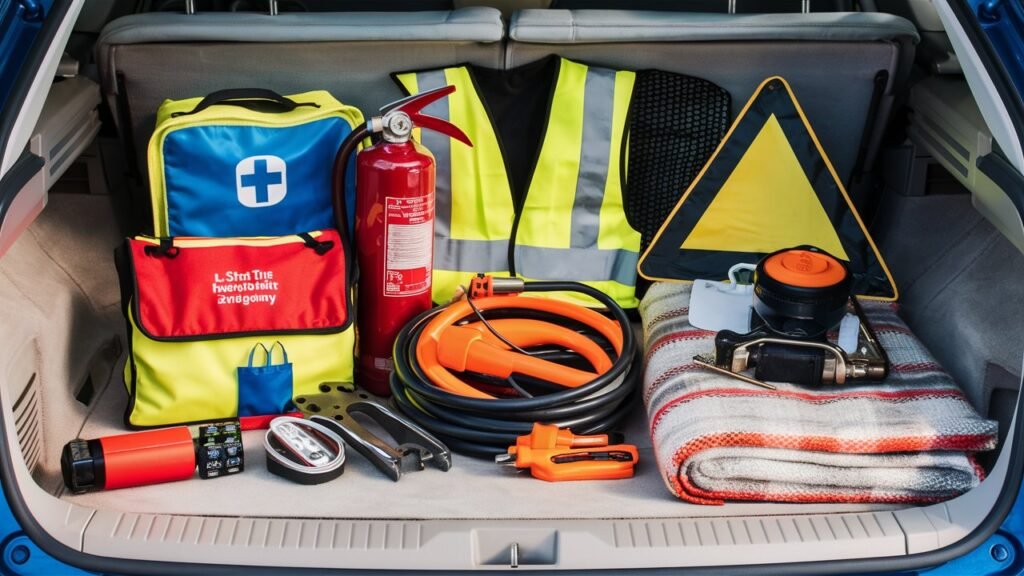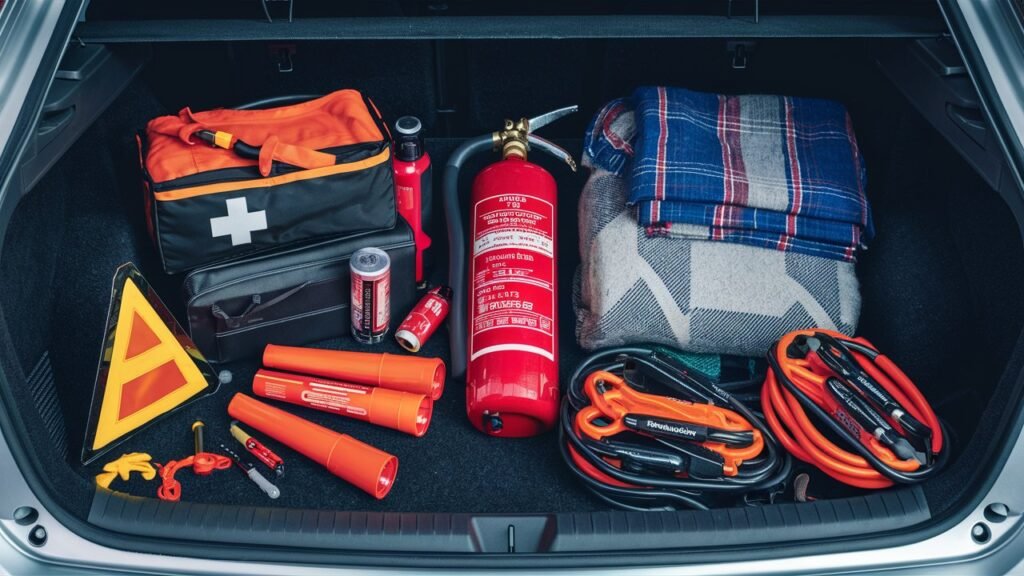Being prepared for emergencies while on the road is paramount for every driver. Whether you’re embarking on a cross-country road trip or simply commuting to work, having the right emergency equipment in your car can make all the difference in critical situations. In this guide, we’ll explore the top 10 essential items that every vehicle should carry to ensure safety and peace of mind on the road.

Emergency Equipment to Keep in Your Car
First Aid Kit
Every vehicle should be equipped with a fully stocked first aid kit. In case of minor injuries or accidents, having bandages, antiseptic wipes, gauze pads, and adhesive tape can provide immediate assistance until professional help arrives.
Jumper Cables
Car batteries can die unexpectedly, leaving you stranded on the roadside. Jumper cables are indispensable for jump-starting your vehicle with the help of another car. Make sure they are long enough to reach between vehicles comfortably.
Emergency Blanket
In cold weather conditions, an emergency blanket can help prevent hypothermia by retaining body heat. Compact and lightweight, these blankets are designed to provide insulation and protection from the elements.
Flashlight with Extra Batteries
A reliable flashlight is essential for illuminating dark roadside areas or inspecting your vehicle at night. Ensure you have spare batteries to avoid being left in the dark during emergencies.
Reflective Triangle
In the event of a breakdown or accident, a reflective triangle can alert other drivers to your presence, reducing the risk of collisions. Place the triangle a safe distance behind your vehicle to warn approaching traffic.
Multipurpose Tool Kit
A multipurpose tool kit containing items such as a screwdriver, pliers, wrenches, and duct tape can help with minor repairs or adjustments on the go. Choose a compact and durable kit that fits easily in your car’s trunk.

Portable Tire Inflator
Flat tires are a common roadside issue, and having a portable tire inflator can save you time and hassle. These compact devices allow you to inflate a punctured tire temporarily, enabling you to reach a service station safely.
Fire Extinguisher
Though rare, vehicle fires can occur due to electrical faults or engine malfunctions. A small fire extinguisher rated for automotive use can help contain flames and prevent them from spreading, potentially saving lives and property.
Non-Perishable Snacks and Water
In case of unexpected delays or emergencies, having non-perishable snacks and bottled water can sustain you until help arrives. Choose high-energy snacks such as granola bars, nuts, and dried fruits for prolonged storage.
Emergency Contact Information
Keep a list of emergency contacts, including roadside assistance services, towing companies, and family members, in your glove compartment. This information can expedite the response time in critical situations.
Frequently Asked Questions (FAQs)
Q: Should I periodically check the condition of my emergency equipment?
A: Yes, it’s essential to inspect your emergency equipment regularly to ensure it’s in good working condition. Replace expired items and replenish supplies as needed.
Q: Are there any legal requirements regarding emergency equipment in vehicles?
A: Regulations regarding mandatory emergency equipment vary by region. Check your local laws to ensure compliance with safety standards.
Q: Can I customize my emergency kit based on specific needs or preferences?
A: Absolutely! Tailor your emergency kit to suit your individual requirements, taking into account factors such as climate, terrain, and the duration of your journeys.
Q: How should I store perishable items in my emergency kit?
A: Store perishable snacks and water in a cool, dry place within your vehicle to prevent spoilage. Replace them periodically to maintain freshness.
Q: Are there any additional items I should consider adding to my emergency kit?
A: Depending on your circumstances, you may want to include items such as a multi-tool, tire pressure gauge, or portable phone charger for added convenience.
Q: What should I do if I encounter an emergency situation on the road?
A: Stay calm, assess the situation, and prioritize safety. Follow appropriate procedures, such as moving your vehicle to a safe location and contacting emergency services if necessary.
Conclusion
By equipping your vehicle with the essential emergency equipment outlined in this guide, you can enhance your safety and preparedness while on the road. Remember to regularly inspect and replenish your supplies to ensure they remain effective in critical situations. Being proactive and well-prepared can make all the difference in handling emergencies with confidence and peace of mind.

